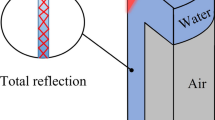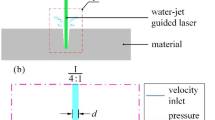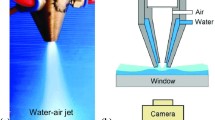Abstract
In the water jet-guided laser processing technology, the stability and impact characteristics of water jet have an important impact on the processing quality. In order to study the influence of the structure of the water-laser coupling cavity and the nozzle on the flow characteristics of water jet, the numerical models of the flow field in the water-laser coupling cavity and the water beam fiber are established, and the distribution characteristics of the velocity and turbulent kinetic energy are simulated and analyzed. The Taguchi method is used to build a simulation model with the nozzle cylinder length, the diffusion length and the diffusion angle as design variables, and the stable length and impact force of water beam fiber as the evaluation indexes. The nozzle structure parameters are optimized based on variance analysis and signal-to-noise ratio analysis. Finally, the simulation results are verified by experiments. The results show that when the channel distribution in the water-laser coupling cavity is 8 × 8 structure, the flow velocity and turbulent kinetic energy distribution in the flow field are more uniform, and the streamline concentration at the nozzle inlet is better. The stable length of the water fiber obtained by nozzle optimization is 4% higher than that before optimization, and the impact force of water jet increases by 16.9%. The error between the experimental and simulated values of the stable length and impact force are less than 4.9%, indicating that the numerical simulation results of the water beam fiber are reliable.


























Similar content being viewed by others
Abbreviations
- RANS:
-
Reynolds equation
- LES:
-
Large eddy simulation
- CLSVOF:
-
Coupled level set and volume of fluid method
- k :
-
Turbulence kinetic energy (m2/s2)
- ε :
-
Turbulent dissipation rate (m2/s3)
- u :
-
Velocity vector
- µ :
-
Dynamic viscosity (Pa s)
- t :
-
Time (s)
- ρ :
-
Density (kg/m3)
- p :
-
The pressure on the fluid microelement (Pa)
- ν w :
-
The kinematic viscosity of water (m2/s)
- F I :
-
The impact force on the target plate (N)
- F n :
-
The component force of FI in the vertical direction of the target plate (N)
- ϕ :
-
The angle between the water jet and the target plate (°)
- S A B :
-
The flow area of thin water chamber inlet (mm2)
- L AB :
-
Thin water chamber inlet circumference (mm)
- h :
-
Thin water chamber thickness (mm)
- R :
-
Thin water chamber radius (mm)
- ρ w :
-
Density of water (kg/m3)
- u w :
-
The axial velocity of water jet (m/s)
- Q w :
-
The flow rate of water (m3/s)
- µ w :
-
The dynamic viscosity of water (Pa s)
- ANOVA:
-
Analysis of variance
- SNR:
-
Signal–noise ratio
- RMSE:
-
Root-mean-square error
- NRMSE:
-
Normalized root-mean-square error
References
Aabid A, Khan SA (2020) Investigation of high-speed flow control from CD nozzle using design of experiments and CFD methods. Arab J Sci Eng 46(2):2201–2230
Adelmann B, Ngo C, Hellmann R (2015) High aspect ratio cutting of metals using water jet guided laser. Int J Adv Manuf Technol 80(9–12):2053–2060
Bao J, Long Y, Tong Y, Yang X, Zhang B, Zhou Z (2016) Experiment and simulation study of laser dicing silicon with water-jet. Appl Surf Sci 387(11):491–496
Chen B, Ding Y, Li Y, Li J, Xu J, Li Q, Yang L (2021) Coaxial helical gas assisted laser water jet machining of SiC/SiC ceramic matrix composites. J Mater Process Technol 293:117067
Dumouchel C (2008) On the experimental investigation on primary atomization of liquid streams. Exp Fluids 45(3):371–422
Etzold M, Deswal A, Chen L, Durst F (2018) Break-up length of liquid jets produced by short nozzles. Int J Multiph Flow 99:397–407
Gong C, Mingxiong Ou, Jia W (2019) The effect of nozzle configuration on the evolution of jet surface structure. Results Phys 15:102572
Huang YX, Zhao YW, Yang LF, Zhou J, Jiao H, Long YH (2019) Theoretical study of water jet guided laser technology based on non-uniform electric field deflection water jet. Opt Commun 442(1):31–39
Jiang Y, Li H, Hua L, Zhang D (2020) Three-dimensional flow breakup characteristics of a circular jet with different nozzle geometries. Biosys Eng 193:216–231
Juraeva M, Song DJ, Kang DJ (2019) Computational optimization approach to design a water-jet nozzle for a water-jet loom using the design of experiment method. J Mech Sci Technol 33(2):631–637
Kumar A, Sahu S (2019) Large scale instabilities in coaxial air-water jets with annular air swirl. Phys Fluids 31(12):124103
Kumar A, Sahu S (2020) Influence of nozzle geometry on primary and large-scale instabilities in coaxial injectors. Chem Eng Sci 221:115694
Lad VN, Murthy Z (2016) Effects of the geometric orientations of the nozzle exit on the breakup of free liquid jet. J Mech Sci Technol 30(4):1625–1630
Leo G, Sekar S, Arivazhagan S (2018) Experimental investigation, optimization and ANN model prediction of a gasoline premixed waste cooking oil fueled HCCI-DI engine. J Braz Soc Mech Sci Eng 40(2):49
Madhukar YK, Mullick S, Nath AK (2016) A study on co-axial water-jet assisted fiber laser grooving of silicon. J Mater Process Technol 227:200–215
Mullick S, Madhukar YK, Roy S, Kumar S, Shukla DK, Nath AK (2013) Development and parametric study of a water-jet assisted underwater laser cutting process. Int J Mach Tools Manuf 68:48–55
Mullick S, Madhukar YK, Roy S, Nath AK (2016) Performance optimization of water-jet assisted underwater laser cutting of AISI 304 stainless steel sheet. Opt Lasers Eng 83:32–47
Oleg U, Marcel C, Roman T, Sergiy A (2021) Investigation of the flow phenomena in high-pressure water jet nozzles. Chem Eng Res Des 165:320–332
Panneerselvam T, Kandavel TK, Aravinda Sreenivas S, Karthik S, Marshal Andru M (2021) Effects of working parameters on performance characteristics of cutting tools processed through powder metallurgy under turning operation. J Mater Eng Perform 30(4):2890–2898
Qiao H, Cao Z, Cui J, Zhao J (2021) Experimental study on water jet guided laser micro-machining of mono-crystalline silicon. Opt Laser Technol 140:107057
Rashed CAA, Romoli L, Tantussi F, Fuso F, Burgener M, Cusanelli G, Allegrini M, Dini G (2013) Water jet guided laser as an alternative to EDM for micro-drilling of fuel injector nozzles: a comparison of machined surfaces. J Manuf Process 15(4):524–532
Salvador FJ, Ruiz S, Crialesi-Esposito M, Blanquer I (2018) Analysis on the effects of turbulent inflow conditions on spray primary atomization in the near-field by direct numerical simulation. Int J Multiph Flow 102:49–63
Spiegel A, Vago N, Wagner FR (2004) High efficiency Raman scattering in micrometer-sized water jets. Opt Eng 43(2):450–454
Sun D, Han F, Ying W (2019) The experimental investigation of water jet-guided laser cutting of CFRP. Int J Adv Manuf Technol 102:719–729
Trimzi MA, Ham YB, An BC, Park JH, Yun SN (2019) Numerical analysis and simulation of an impulse driven piezoelectric needle-free jet injector. J Mech Sci Technol 33(8):3851–3858
Vágó N, Spiegel Á, Couty P, Wagner FR, Richerzhagen B (2003) New technique for high-speed microjet breakup analysis. Exp Fluids 35(4):303–309
Wen J, Chen C, Qi Z, Campos U, Pei X (2019a) Bionic optimum design of straight cone nozzle and the effectiveness evaluation of reducing fluid resistance. J Braz Soc Mech Sci Eng 41(9):358
Wen J, Qi Z, Behbahani SS, Pei X, Iseley T (2019b) Research on the structures and hydraulic performances of the typical direct jet nozzles for water jet technology. J Braz Soc Mech Sci Eng 41(12):570
Wu Y, Zhang G, Wang J, Chao Y, Zhang W (2021) The cutting process and damage mechanism of large thickness CFRP based on water jet guided laser processing. Opt Laser Technol 141:107140
Yang Y, Li W, Shi W, Zhang W, EI-Emam MA (2019) Numerical investigation of a high-pressure submerged jet using a cavitation model considering effects of shear stress. Processes 7(8):541
Zhou M, Kong L, Xie L, Fu T, Guo Z, Feng Q (2017) Design and optimization of non-circular mortar nozzles using finite volume method and Taguchi method. Int J Adv Manuf Technol 90(9):3543–3553
Acknowledgements
This research was funded by the National Natural Science Foundation of China (Grant No. 51875328) and the National Natural Science Foundation of Shandong Province (Grant No. ZR2019MEE013). The simulation of this study adopts ANSYS software (S/N: 308992).
Author information
Authors and Affiliations
Corresponding author
Ethics declarations
Conflict of interest
The authors declare no conflicts of interest in this manuscript.
Rights and permissions
About this article
Cite this article
Liu, Q., Zhao, Y., Meng, J. et al. Research on the Influence of Water-Laser Coupling Cavity and Nozzle Structure on the Flow Characteristics of Water Beam Fiber. Iran J Sci Technol Trans Mech Eng 47, 363–380 (2023). https://doi.org/10.1007/s40997-022-00524-x
Received:
Accepted:
Published:
Issue Date:
DOI: https://doi.org/10.1007/s40997-022-00524-x




